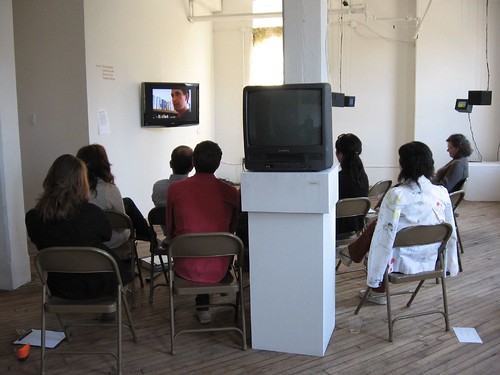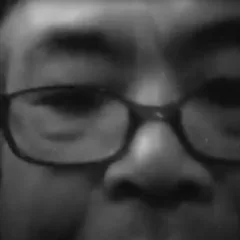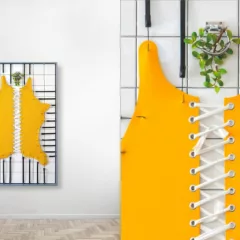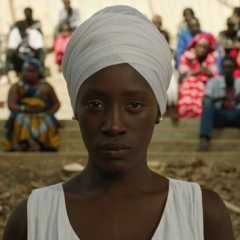
(left to right) Roberta, Nadia, Anita, Andrew (behind column), Leah, Juliana (behind Leah), Josh, and Roxana
Artblog loves Art 21 so we invited artists from Vox Populi to screen some of Art 21’s episodes with us–a sort of focus group for the newest iteration of the show, which is scheduled to air on PBS beginning Oct. 28.
We–Roxana Perez-Mendez, Andrew Suggs, Julianna Foster, Anita Allyn, Nadia Hironaka, Leah Bailis, Josh Rickards plus the artblog duo Roberta and Libby–looked at five episodes out of the 16 , which will be spread over four programs. We laughed, we groaned and we kvetched. Here’s how it went:
Protest — (The Slipperiness of Truth)
An-My Le
“War was part of life for us (in Vietnam).”
“When I’m working with the military I’m still thinking landscape.”
Discussion:
(Discussion centered around the genre of war photography and on the slipperiness of the facts the photographer purports to cover. You can’t trust the pictures as representations of the past or of what she thinks. PS None of us could pronounce her name and there is no narrator to introduce the artist. Each segment launches right in to the “you are there” in the studio.)
Anita-I find it weird she didn’t frame the work as war photography.
Roxana-What’s with the nagging boyfriend (who shows up in the video and seems to do some micro-managing of her projects)?
Ecology
Ursula Van Ridingsvaard
–she grew up in a refugee camp for Polish refugees in Germany post WW 2. She said her home was silent; her home was a raw wooden barracks; she learned from the vernacular.
“Working hard was the answer to life.”
“The cutters are the princes of my studio.”
“I’m grateful to my anger.”
Discussion
(Everyone was confused about why this artist and her work were in the Ecology section.)
Roxana– As soon as the episode — heavy on the artist’s repetitive process — was over, Roxana quipped, “Is everyone awake?”
Andrew–“The objects are an afterthought to the process.
Leah– Leah liked the imposing scale of the work. “I really like her work. Seeing it on a video screen doesn’t do it much justice.”
Andrew– “As much as she talks about landscape she’s using a helluva lot of planked wood…Why is it in the ecology section?”
Ecology
Mark Dion
“I shop”
“I’m not really interested in nature. I’m interested in ideas about nature.”
Dion, looking at his assistant who is putting tar on dead lab rats hanging off a dead tree, “That’s perfect.”
Discussion
(Everyone agreed he was funny. The episode follows Dion through a project moving a dead tree and its ecosystem to a specially-created greenhouse in Seattle. Tree upkeep required a large staff, a computerized water system, electrically moveable solar panels. People were disturbed by the art’s use of what appeared to be ecology for something antithetical to ecology.)
Leah-Leah complained he was depleting “natural resources–all that water power!” to keep the ecosystem alive.
Andrew–“How much did this cost?! …ecology is very in vogue right now.”
Mark Bradford – Paradox
He explained his art in terms of growing up the son of a beauty shop owner and having to make signs for her shop. The hand was important in his art from the beginning. The signs in the neighborhood were important and have become the substance of some of his art work, collaged onto canvases. In the context of explaining how excited he was about learning art history in school and especially postmodernism, he said “I told my mom…you know you’re postmodern!”
Discussion
(People were interested in how much personal information you have to know to understand an artist’s work. How to intellectually position your art was a big part of this discussion since Bradford did not intellectualize his art so much and was very personable to boot. Everyone loved him but they were worried about how much intellectualizing was too much or not enough. They then got into a discussion about the romantic idea of the artist… and artblog got confused.).
Jules-It’s nice to hear the history of his mother and the posters.
Andrew–“Oh my childhood in the barracks (referring back to Ursula)! Oh my childhood in the beauty parlor! I have to have the trope about my tortured past and my art but I loved hearing about his learning about art history.”
Leah–this is as much about the artist as the art.
Roxana–Coming at it another way, Roxana says that after all the revelations or intimacies she feels better about the work.
Josh–“It’s still the romantic idea of the artist.”
Jennifer Allora and Guillermo Calzadilla-Paradox
They are interested in materials and in disrupting the norms of a setting. They made giant chalk sticks for people in Lima to write protest messages on the street outside the government offices. Libby, who had visited Peru a year ago, noted the use of chalk because people there write enormous political messages on mountainsides using a white chalky mixture. Other projects shown had anti-war and anti-militarist themes.
Discussion
(Allora did most of the talking and her intensity was a little overwhelming for the group. Calzadilla didn’t say much. We had just been talking about intellectualizing and here she was intellectualizing in spades. People were interested in the collaboration and how it worked.)
Roxana-“She’s the brains and he’s the braun a little bit… She brought the ability to intellectualize…(to the collaboration).”
Josh-They had a nice work space!”
Nadia-“Whoever filmed it acknowledged it (the nice space) by starting at the ceiling and moving down.”
Nadia-“Matt and I are starting to work on a project together. It is so hard. We’re still arguing about the approach to talking about it.”
Anita–Talking about the collaboration, “How do you negotiate and what do you fight for?”
Roxana–“She is from Philadelphia and he is from Puerto Rico and they have been working the tropics and semi-political issues and they don’t spend a lot of time (in the video) talking about that.”
Conclusion
It’s worth seeing all these studio visits; our biggest complaint was the lack of context–no sense of authorship of Art 21. Sometimes that makes the interviews a little bit confusing and value neutral.
In previous episodes, they had a narrative thread and narrators (our fave was John Waters). Maybe it’ll be in the televised version, but it’s not on the preview dvds, and we think it was needed. For example we needed an explanation why Allora and Calzadilla were in the episodes entitled Paradox; we thought they would be a better fit in Politics. We don’t even know what Paradox means in this context. And how about that Ecology category which included Dion and von Rydingsvard? They may use natural materials, but their subject matters are something else entirely.
But forget our kvetches and watch it on WLVT, Channel 39, the Lehigh Valley PBS station. We’re sorry to report that poopy Channel 12 doesn’t have it; they thought I, Claudius was sexier, we guess. The programs give each artist 15 minutes. That’s an extraordinary amount of time in a 90-second medium that usually shuns art.










